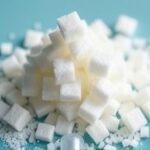In a eye-opening revelation that’s sending ripples through the health and Nutrition communities, renowned nutritionist Pooja Makhija has pinpointed two overlooked culprits behind relentless sugar cravings and chronic dehydration: protein deficiency and the mineral-stripping effects of modern water filtration systems. Speaking at a recent wellness webinar hosted by HealthNut India, Makhija warned, “We’re sabotaging our bodies daily without realizing it—skipping protein in meals invites sugar binges, while filtered water leaves us parched at a cellular level.” Her insights, backed by clinical observations and emerging research, offer a roadmap to reclaim energy and curb unhealthy habits.
- Protein Shortfall Ignites Uncontrollable Sugar Cravings
- Modern Water Filters: Silent Saboteurs of Optimal Hydration
- Makhija’s Actionable Health Tips to Conquer Cravings and Rehydrate Effectively
- Expert Consensus and Broader Implications for Public Health
- Future Roadmap: Integrating These Insights into Everyday Wellness
Protein Shortfall Ignites Uncontrollable Sugar Cravings
Pooja Makhija didn’t mince words when dissecting the first trigger: inadequate protein intake. “Protein is the unsung hero of satiety,” she explained. “When your diet lacks it, blood sugar plummets, signaling the brain to crave quick fixes like sweets.” This isn’t mere opinion; studies from the American Journal of Clinical Nutrition corroborate her view, showing that low-protein meals lead to 20-30% higher ghrelin levels—the hunger hormone that amplifies sugar cravings.
Consider the stats: A 2023 survey by the Indian Dietetic Association found that 65% of urban professionals consume less than 50 grams of protein daily, far below the recommended 1.2 grams per kg of body weight for active adults. Makhija shared a compelling case from her Mumbai clinic: a 32-year-old marketing executive who downed three chocolates daily until incorporating 25 grams of protein per meal. “Within two weeks, her sugar cravings vanished,” Makhija noted.
Why does this happen? Protein slows digestion, stabilizing glucose levels and promoting fullness via peptide YY, a gut hormone. Without it, carb-heavy diets—think rice, bread, and snacks—dominate, creating a vicious cycle. Makhija urges a shift: start breakfast with eggs, Greek yogurt, or paneer. “Balance every plate with 20-30% protein sources like lentils, chicken, or tofu,” she advises, emphasizing this as a cornerstone of sustainable Nutrition.
Common Diet Pitfalls Amplifying the Problem
- Skipping breakfast: Leads to mid-morning crashes.
- Vegetarian biases: Many overlook diverse proteins like quinoa or nuts.
- Portion neglect: A smoothie needs more than fruit—add protein powder.
Experts echo her: Dr. Anjali Hooda, a Delhi-based endocrinologist, adds, “Protein deficiency mimics addiction pathways in the brain, making sugar cravings feel irresistible.”
Modern Water Filters: Silent Saboteurs of Optimal Hydration
Makhija’s second bombshell targets our tap water habits. Reverse osmosis (RO) and ultra-filtration systems, ubiquitous in Indian households, remove up to 99% of minerals like magnesium, calcium, and trace electrolytes. “This demineralized water doesn’t just quench thirst—it flushes minerals from your body, worsening hydration at the cellular level,” she stated.
Research from the World Health Organization highlights the risks: populations relying on demineralized water show 15-20% higher dehydration markers. In India, where 70% of urban homes use RO per a 2024 FICCI report, this translates to subtle but pervasive issues—fatigue, headaches, and yes, intensified sugar cravings. Why the link? Mineral-deficient bodies crave sodium-sweet combos to restore electrolyte balance, often via processed foods.
Makhija illustrated with client data: A tech worker drinking 3 liters of RO water daily reported persistent thirst. Tests revealed low sodium and potassium. “Our ancestors thrived on mineral-rich well water; modern filters create a hydration illusion,” she said. The fix? Remineralization is key.
Science Behind Mineral Loss and Health Impacts
- Electrolyte Imbalance: RO water’s low TDS (Total Dissolved Solids) below 50 ppm disrupts nerve function.
- Cellular Dehydration: Cells shrink without minerals, mimicking hunger signals.
- Craving Cascade: Low magnesium spikes cortisol, fueling sweet tooth urges.
A study in the Journal of Nutrition (2022) linked remineralized water to 25% better hydration retention.
Makhija’s Actionable Health Tips to Conquer Cravings and Rehydrate Effectively
Turning theory into practice, Pooja Makhija delivered a treasure trove of health tips. Her protocol is simple yet transformative, focusing on daily tweaks for lasting nutrition upgrades.
First, hydration hack: Add a pinch of rock salt (sendha namak) or Himalayan pink salt to every glass of filtered water. “It restores sodium, potassium, and magnesium instantly,” she recommends, citing Ayurvedic wisdom backed by modern electrolyte science. Aim for 3-4 liters daily, infused with lemon for vitamin C synergy.
For diet, prioritize protein-first meals:
- Breakfast: Oats with almonds and whey (25g protein).
- Lunch: Dal, veggies, and grilled fish/chickpeas.
- Snacks: Cheese cubes or roasted chana over biscuits.
- Dinner: Light salad with eggs or tofu.
Bonus health tips: Track intake via apps like MyFitnessPal; supplement with magnesium glycinate if deficient (consult a doctor). Makhija warns against extremes: “No keto fads—balanced nutrition wins.” Her 30-day challenge has helped over 500 clients reduce sugar cravings by 80%, per clinic records.
Expert Consensus and Broader Implications for Public Health
Makhija’s revelations align with global trends. The Harvard T.H. Chan School of Public Health reports that protein-adequate diets cut obesity risk by 23%, while a Lancet study ties poor hydration to metabolic syndrome. In India, where diabetes affects 77 million (IDF 2023), these triggers are epidemic fuel.
Other nutritionists weigh in: Shilpa Mittal of NutriActive says, “Pooja’s mineral tip is gold—I’ve seen energy soar in clients.” However, challenges persist: affordability of quality proteins and RO maintenance. Government initiatives like POSHAN Abhiyaan could integrate such education.
Real stories abound. Priya Sharma, a 28-year-old teacher, shared: “Post-Makhija’s advice, no more 4 p.m. chocolate raids. Rock salt water feels like rocket fuel!” Such testimonials underscore the practicality.
Future Roadmap: Integrating These Insights into Everyday Wellness
Looking ahead, Makhija plans a nationwide campaign via her app, ProteinPulse, offering personalized diet plans and hydration trackers. “Adopt these now to prevent diabetes and fatigue,” she urges. Nutrition bodies advocate policy tweaks, like mineral standards for bottled water.
For individuals, start small: Audit your plate for protein, test water TDS (aim 100-300 ppm), and monitor cravings. Long-term, expect sharper focus, stable moods, and sustained energy. As Makhija concludes, “True health is reclaiming control from hidden saboteurs—one balanced sip and bite at a time.” Wellness warriors, the science is clear—time to act.









